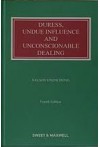- Author(s): Nelson Enonchong
- Publisher: Sweet & Maxwell
- Edition: 4 Ed 2023 (South asian Ed)
- ISBN 13 9788198223432
- Approx. Pages 574 + Contents
- Format Hardbound
- Approx. Product Size 24 x 18 cms
- Additional Details South Asian Edition
- Delivery Time 3-5 working days (within Kerala & South India) (Others 7-9 days)
- Shipping Charge Extra (see Shopping Cart)
...................................................................................................................................
Description
In the period since the last edition of this book there have been significant developments in the law relating to duress, undue influence and unconscionable dealing. In the area of duress, discussed in Pt I, the Supreme Court, in Times Travel International (UK) Ltd v Pakistan International Airlines Corp (2021) clari- fied the elements of duress, addressed the controversial issue whether the doctrine of "lawful act" duress exists in English law and provided some authoritative guid- ance on the thorny issue of how to determine whether pressure applied by means of a lawful act or a threat of lawful action may be regarded as illegitimate and constitute duress. Following the guidance of the Supreme Court on lawful act duress, in Al Saif Group v Cable (2022) the High Court addressed the question of the circumstances when exploitation of knowledge of criminal activity, by a threat to report a crime or initiate criminal proceedings, can constitute illegitimate pressure. In Al-Subaihi v Al-Sanea (2021) the High Court was concerned with the question whether a threat to institute civil proceedings that can lead to a travel ban and/or asset freezing could be regarded as illegitimate pressure.
In Law Debenture Trust Corp Plc v Ukraine (2023), the Supreme Court ad- dressed the question whether a threat by one foreign state to use physical violence against the armed forces and civilians of another foreign state and a threat to dam- age or destroy property in the threatened state can constitute duress under English law. In the same case, the Supreme Court also considered, among other things, the question whether the imposition (or the threat of) trade restrictions by one state to exert pressure on another state, in order to achieve political objectives, can constitute illegitimate pressure so that it can amount to duress under English law. Stilll in the Ukraine case, the Supreme Court also commented on the question is causation in the context of duress, recognising that current authorities indicate that the test for causation depends on the type of pressure applied. In Morley v Royal Bank of Scotland Plc (2021) the Court of Appeal addressed the issue of causation in the context of duress in circumstances where the complainant had negotiated a better deal after the defendant's threats.
In relation to undue influence, dealt with in Pt II, the courts have discussed a number of issues. First, concerning the nature of undue influence, in Wood v Com- mercial First Business Ltd (2019) the question whether the court needs to be satis- fied that there has been wrongdoing or improper conduct before making a finding of undue influence was considered. Secondly, in relation to the essential elements of presumed undue influence, in a number of cases (Gladstone v White (2023), Chin v Chin (2019); and Sollis v Leyshon (2018)), in discussing the first element, whether there was a relationship of influence, the courts have addressed the ques- tion whether, on the particular facts of each case, there was a relationship of influ- ence arising from the complainant's vulnerability due to their reliance or depend- ence on the other party. In Enal v Singh (2022) the Privy Council also considered the question whether there was a relationship of influence based on dependence. The second element required for the presumption of undue influence to arise, that the transaction is one that calls for explanation, was considered by the Privy Council in Nature Resorts Ltd v First Citizens Bank Ltd (2022) and by the High Court in Bird v Lantern Recovery LLP (2021), where the transaction was between a mother and son.
..................................................................................................................................
Contents
PART 1-DURESS
CHAPTER 1 General Introduction.
CHAPTER 2 The Nature of Duress
CHAPTER 3 Is the Pressure Illegitimate?
CHAPTER 4 Causation
CHAPTER S Types of Duress
PART II-UNDUE INFLUENCE
CHAPTER 6 Introduction to Part II
CHAPTER 7 Equitable Undue Influence
CHAPTER 8 Actual Undue Influence
CHAPTER 9 Presumed Undue Influence
CHAPTER 10 The First Requirement: A Relationship of Influence
CHAPTER 11 The Second Requirement: A Transaction that Calls for Explanation
CHAPTER 12 Rebutting the Presumption of Undue Influence
CHAPTER 13 Undue Influence in Probate Law
CHAPTER 14 Abuse of Confidence
PART III - UNCONSCIONABLE DEALING
CHAPTER 15 General Introduction to Part III
CHAPTER 16 Special Disadvantage
CHAPTER 17 Is the Stronger Party's Conduct Unconscionable?
CHAPTER 18 Is the Transaction Oppressive?
CHAPTER 19 Independent Advice
CHAPTER 20 Scope of Unconscionable Dealing
PART IV - THIRD PARTY DURESS, UNDUE INFLUENCE OR UNCONSCIONABLE CONDUCT
CHAPTER 21 Introduction to Part IV
CHAPTER 22 The Doctrine of Agency
CHAPTER 23 Actual and Constructive Notice
CHAPTER 24 Constructive Notice: When is a Creditor Put on Inquiry?
CHAPTER 25 Constructive Notice: Steps to be Taken by a Creditor Put on Inquiry and Solicitor's Duty
CHAPTER 26 Constructive Notice: Comparison with Equivalent
PART V - REMEDIES AND DEFENCES
CHAPTER 27 Introduction to Part V
CHAPTER 28 Remedies
CHAPTER 29 Equitable Defences
...................................................................................................................................
Author Details
Nelson Enonchong

